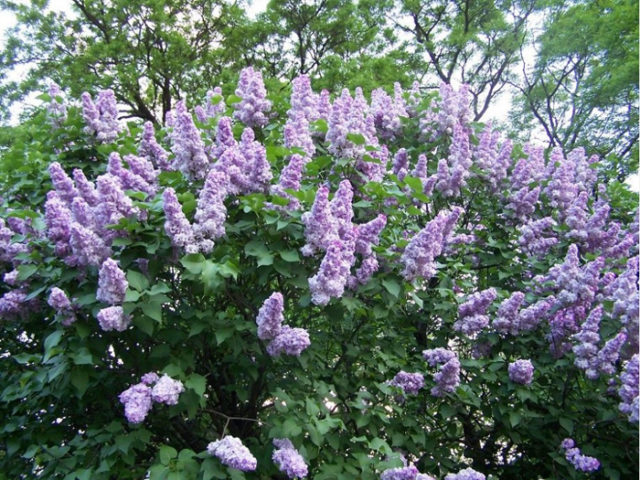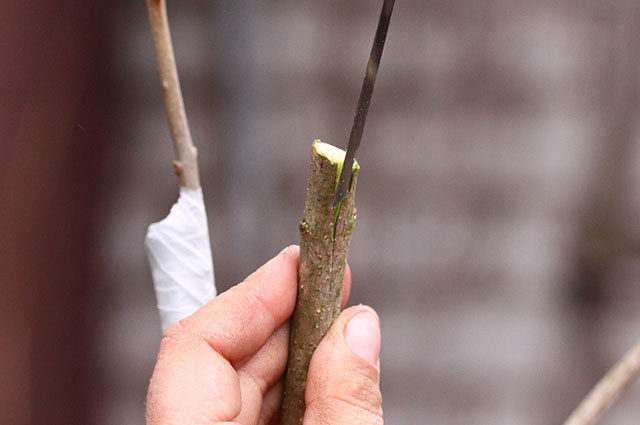Content
It is possible to inoculate lilacs in the spring, first of all, by budding on the awakening bud, however, there are other ways. This procedure is used both for breeding cultivated varietal lilacs and for stimulating flowering. The likelihood of whether a plant will take root or not depends on the nature of the rootstock and compliance with sanitary standards during the vaccination. Before starting work, all tools should be thoroughly disinfected with a solution of potassium permanganate.
Details of the implementation of the lilac inoculation in the spring are shown in the video in this article.
Is it possible to plant lilacs
Many novice gardeners are not sure whether to plant lilacs, because there are more affordable ways to propagate the plant. Sometimes this is not only possible, but necessary.
The fact is that when grown in unfavorable conditions, a lilac bush can weaken greatly. Failure to comply with agricultural standards on the part of a person also weakens the shrub. You can restore the plant by applying top dressing, transplanting to a more favorable place (in terms of soil composition) or by grafting lilacs, and you can do both the spring version and the autumn one.
What can you plant lilacs on
There are not many plants that can be grafted with lilacs. Even fewer are those that can, on the contrary, be grafted onto lilacs.
The following cultures are mainly called:
- wild lilac;
- privet;
- ash;
- Rowan.
Sometimes there is information about grafting lilacs on maple, however, there is no exact data on the survival rate of the plant.
Is it possible to plant lilacs on lilacs
Lilacs are successfully grafted onto their relatives. In particular, a nondescript weakened bush can be turned into a lush bush with abundant flowering due to varietal grafting. This is done by combining a wild plant and a garden varietal culture, where the latter acts as a rootstock.
The reverse process is also possible. You can plant varietal lilacs on wild ones. The result is a plant with improved winter hardiness, endurance and resistance to diseases and pests.
Finally, you can graft a variety on a variety. This grafting allows you to get a bush with mixed characteristics of both varieties.
Is it possible to plant lilacs on an ash tree, on a mountain ash, on a privet
Of other plant species for grafting, ash is most often chosen - this is a related crop belonging to the same family as the lilac, due to which the shoot grafted onto it takes root well.
A completely different situation is observed when trying to inoculate lilacs on privet - this is the most unreliable planting material. The graft does not always take root and rarely a strong plant is obtained from such a combination. Besides, privet is not hardy at all.
It is also not recommended to vaccinate lilacs on mountain ash. The results are quite contradictory, the survival rate is generally average.
What can be grafted onto lilacs
In addition to another variety of lilacs or wild-growing species, you can try to plant an olive tree on a garden bush, however, the plant survival rate is average.
There is also an opinion that you can graft an apple tree or a plum on a lilac. Gardeners give different answers, however, the correct one is not.These crops belong to different families.
Scion preparation
Graft lilacs are harvested as follows:
- From a bush with a particularly lush flowering, it is necessary to cut off cuttings with buds that have not yet had time to open.
- It is believed that the best grafting takes root, the stalk for which was cut from one-year semi-lignified shoots.
- The harvested cuttings are stored in a cellar or refrigerator, but not in the freezer. Before that, they are wrapped in paper.
- Half an hour before grafting, it is advisable to lower the cuttings into any growth stimulant.
In order for the procedure to be successful, it is necessary to adhere to a number of rules during the connection of the scion and rootstock:
- Cuttings for grafting are cut from proven bushes. The grower needs to know which variety he is planting. It is also important that the plant is healthy.
- Ripe annual shoots are best suited as a scion.
- Shoots cut from the upper part of the bush, which receives the greatest amount of sunlight, take root especially successfully.
- It is better to cut the cuttings from the southern side of the shrub, because the leaves on it in the axils have well-developed eyes and short internodes.
How to plant lilacs correctly
It is recommended to vaccinate lilacs early in the morning or in the evening, when there is no scorching sun. It is advisable to carry out the procedure in dry, cloudless weather. The increased humidity of the air lowers the survival rate of the scion.
Cuttings are usually grafted onto the root shoots of the shrub. The procedure is carried out according to the following scheme:
- In March, as soon as the soil thaws and softens, it is necessary to dig out the annual shoots. Of these, samples are selected that correspond in thickness to the existing cuttings. Among these shoots, preference is given to those that grow farther from the bush. Instances with thin and weak roots are discarded.
- All shoots are cut off from the rhizome, but at the same time one strong shoot is left. Light shoots and buds located underground are also cleaned so that they do not weaken the stock and do not act as "competitors" for grafting.
- The rhizome of each rootstock is hidden as quickly as possible in a plastic bag so that it does not dry out, and tied up at the root collar with a rope or tape.
Timing of vaccination of lilacs
The timing of inoculation of lilacs in the spring is determined by the beginning of sap flow, which most often occurs in the last days of March - early April. Outwardly, this manifests itself in the fact that the kidneys become full and increase in size. The grafting is carried out directly after the onset of sap flow, but the cuttings are cut at the end of winter before the buds awaken.
Also, cuttings for grafting lilacs in the spring months can be prepared in the fall.
Preparation of tools and materials
In order to vaccinate, you need the following materials and tools:
- rootstock - a plant that is inoculated;
- scion - cut annual shoots (cuttings);
- garden shears for cutting cuttings;
- special grafting knife for budding.
Spring grafting of lilac in different ways
For gardeners without experience in plant grafting, the most suitable method is that lilacs are grafted in spring through simple copulation without cutting "tongues" or splits. This method will avoid possible damage to the shoots when the branches are split too much.
Vaccination by simple copulation implies the following sequence of actions:
- With the help of garden scissors, the stock is cut to a height of 60 cm. The lilac should not be grafted above - in this case, the stock often forms shoots below the grafting site.
- The next step is the preparation of oblique cuts of the same size, both for the rootstock and for the scion. With a budding knife, the stalk is cut obliquely 3-5 mm below the kidneys. The length of the cut should be at least 2-3 times the diameter of the cutting.
- Then the places of the cuts are tightly pressed against each other. It is important to combine the rootstock and the scion in one movement, you cannot rub the sections against each other - this way the graft will not take root due to minor damage to the internal tissues of the bush.
- The top of the cutting is cut off, but at least one pair of buds is left on it.
- After that, the vaccination site is carefully wrapped in polyethylene. The opposite end of the scion is treated with garden varnish so that it does not dry out.
Bark vaccination spend a little differently:
- The stock is cut off and an incision is made in the bark obliquely. The cut length should be approximately 3 cm.
- Then, with the very end of the knife, pry the edge of the bark and bend it slightly so that you can insert the handle.
- After that, the handle is already cut diagonally and inserted into the incision almost to the stop.
- The procedure is completed by tying the vaccination site. To do this, they wrap the knot with a tape, cut off the end of the cutting and lubricate the cut with garden pitch.
For more information on how to vaccinate lilacs in spring or summer, see the video below:
Separately, it is worth mentioning the grafting of lilacs into the cleavage, which is carried out according to the following scheme:
- All buds are removed from the stock and a cut is made on top.
- Then, in the middle of the stock, a split 3-4 cm deep is made. The split should be placed vertically.
- The lilac graft is cut from both sides so that a wedge with edges of 3 cm is obtained.
- Then the scion is inserted into the split, after which the junction is wrapped with polyethylene.
- The procedure is completed by treating all injuries with garden pitch.
Lilac care after vaccination
In order for the vaccine to take root, it is necessary to carefully monitor the development of its kidneys. The scion grows together with the stock in about 2 weeks, after which the grafted stalk begins to grow. Unfortunately, this is nothing more than an idealized situation. In practice, young shoots on the scion may appear only in early to mid-summer.
At the end of September, the garter can be removed from the vaccination site, however, if there are strong gusts of wind on the ground, you should wait a little with this. In extreme cases, the garter is left until spring, but it is important to ensure that it does not grow into the bark. In addition, it is necessary from time to time to remove all young growth that forms on the branches just below the grafting site.
For the rest, the care for the grafted lilac is basic - the bush must be watered from time to time, fed, insulated for the winter and regularly loosened the area of the trunk circle.
Conclusion
Planting lilacs in the spring is easy, especially with proper preparation. It is enough to get acquainted with a couple of videos and take care of the disinfection of the inventory so as not to introduce harmful microorganisms either into the rootstock or into the scion. It is even easier to plant lilacs if you skip the stage of harvesting cuttings and purchase material from a horticultural nursery.
Caring for a grafted plant is also quite simple and does not differ much from the basic one. The result of grafting is multiplied plantings or more lush flowering. The latter is achieved by giving the lilac features of the plant, which is used as a scion or rootstock.
For more information on how to plant lilacs in spring, see the video below:










